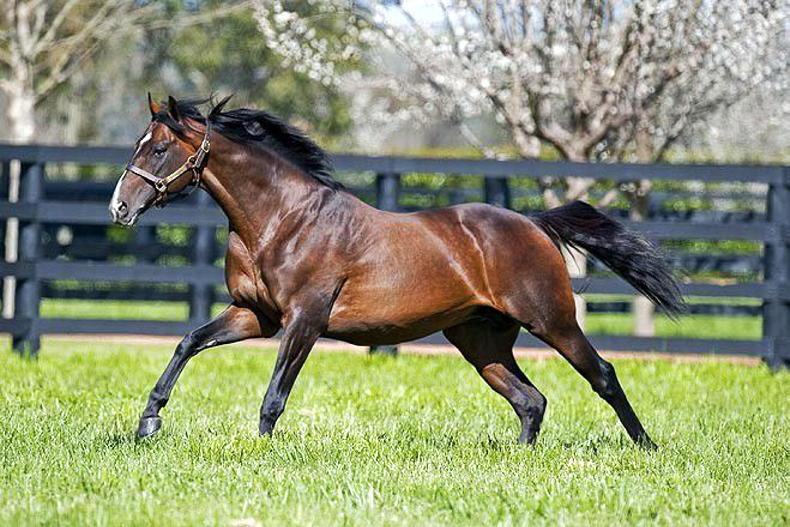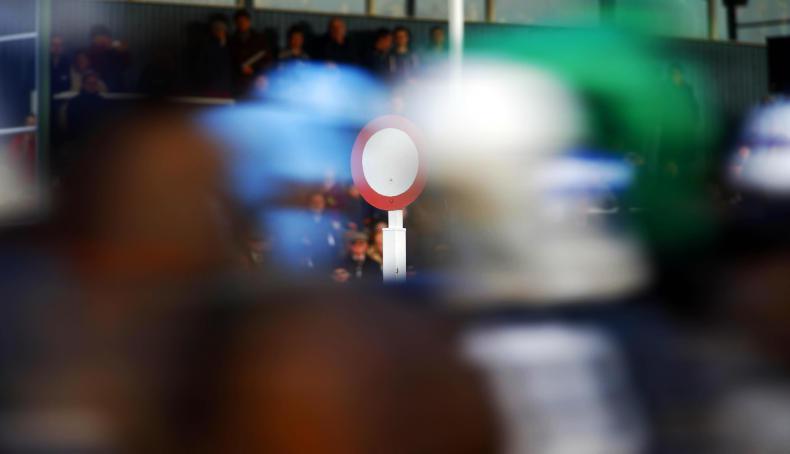IT all started during the pandemic. That time warp that allowed for a unique stock take that saw many a business seed to be sewn. The go-getters were always likely to try and go get something else.
Friends Ger O’Neill and Darragh McCarthy have got plenty in the sport horse game but when everything ground to a halt, they weren’t ones for sitting around playing quizzes on Zoom. It was always going to be a case of finding another door.
The door they found was an entrance into the thoroughbred world via standing a stallion. Four years later, they have infiltrated the building and their Capital Stud operation has thrived.
What started as a toe-dip into the perhaps the choppiest waters of the bloodstock sector has transformed into one of the most progressive start-up operations in any sector of the sport.
There are now six stallions standing at O’Neill’s Bennettsbridge, Co Kilkenny base, with initial acquisition Hunting Horn joined by Triple Threat, Alkumait, Mirage Dancer and most recently by Castle Star and Authorized. The latter, Tiger Roll’s sire, was a huge coup to persuade the Turkish Jockey Club to sell and speaks for the ambition of the stud.
Capital’s growth has come fast, those choppy waters haven’t deterred a smooth sail, and excitingly, it seems like it is only the beginning of this journey because, joined by a significant team of investors, the ambition is to travel far and wide.

“It was Darragh who started it I suppose,” O’Neill says. “He thought we should buy a stallion. It was just an idea. We couldn’t do a whole lot with the show jumping so I suppose it got us thinking of what we could be doing. I had the facilities to stand a stallion so we just went for it really.
“I’ve ridden in point-to-points myself and I used to ride out for Mags Mullins. I’ve always followed the breeding of thoroughbreds, not as closely as I am now, but I was always interested in it. Hunting Horn came on the market and we had him bought before we’d even thought about it too much. He stood here and that’s how we started.
O’Neill has a masterful reputation for producing young horses through his Castlefield Sport Horses operation and has won three gold medals at the World Breeding Championships while also competing at five-star international shows. McCarthy is based in Belgium and is a regular producer of top class show jumping horses that he has sold around the world via his Highfield Stud and Farms banner.
“We have big plans,” McCarthy says. “We’ve said for the next 10 years, we’re going to go as big as we can. We both have origins in the racing game. My own family are breeders, my father (Oliver) and uncle (Pat) bred Ned Kelly. That exposed me to it.
“Growing up through it, you always understood the sales, the nomination fees, not making money, blaming the stallion man for your problems, and I always had it in my head that if we went at the stallion business, we’d look after breeders first and foremost. If the breeder isn’t making money then the stallion man doesn’t deserve to make money.
“We’ve looked after the breeder by going out to the sales and buying our stallion’s progeny, at the top, middle and lower end - we’re trying to support all ends of the scale. We want breeders to know we are there to help. A lot of stud people want to buy the top 5% of their stallions progeny and fair play to them, that is very good, but we want to support every part of it.
“It’s a hard thing to describe but that’s what we’ve promoted ourselves on and I think that’s why we’ve been able to cover big numbers. Maybe in 10 years time our model won’t be financially viable and we end up saying it didn’t work but our model now is that the breeder has to come first.”
A surefire sign of the high regard for O’Neill and McCarthy has been the investors who have come in to get behind the project. Renowned point-to-point trader Donnchadh Doyle, Jerry Horan (Paragon Bloodstock), Cormac O’Flynn, Olympic show jumper Greg Broderick and Double O Racing have come on board.
O’Neill explains: “Myself and Darragh own a majority in most of the stallions and we have different people invested here and there. The day-to-day running is down to us here at the stud obviously and then the decisions of buying and selling stallions, what mares are covered and various other things on that scale is a group thing.
“Those decisions are important but it has always been done in a nice and easy way - when the lads ring you, you’d always enjoy talking to them.
“It’s a situation where everybody involved understands the business. They understand the way things develop with stallions and that is key. For example, with Triple Threat, there was a big input from Donnchadh. I have known Donnchadh for a long time. We would have been in Goresbridge together years ago with show jumpers.
“With Triple Threat, I asked Donnchadh if he knew the horse, and he said he bought two expensive stores and he thought a lot of them and he asked to get involved. Donnchadh has a great knowledge and great contacts in the industry so he’s a great man to have involved.” 
Triumph
The acquisition of Authorized was a triumph of persistence and patience, and speaks of what the operation is all about, the willingness to take a risk at the forefront of an ambitious long-term strategy.
“It all started through a chance meeting with a Turkish man based here in Ireland,” O’Neill recalls. “He came in here to look at a horse and I asked about Authorized and whether he’d think there was any chance to buy him and he said no. He did put us in touch with someone in the Turkish Jockey Club but again the answer was no straight away.
“Eventually after going back and forth they decided they might give us a price but then we found out we couldn’t get any insurance on him because he was 20. So this process went on for six to nine months and at one point we just decided, let’s go over and have a look at him. He was in good order, so we said, let’s just go and buy him without insurance.
“I think we kind of all agreed it was a risk worth taking and that if it didn’t work, we’d just let it go and move on. Authorized is such a brilliant stallion and the market wants him and it just felt right to bring him back to Ireland. So far everything has gone well with mares scanning in foal, so we’re a bit more relaxed now than we were when we first got him.
“There has been a lot of talk about the impact of the French-breds at Irish sales, so to have that sort of stallion in Ireland is a huge help, and will help more for the breeding of the future.”
Polarisation
The talk O’Neill refers to was prevalent at the most recent National Hunt Irish Thoroughbred Breeders Association seminar, where the French influence was discussed but also the polarisation of stallions, with Walk In The Park and Blue Bresil stock dominating the foal sales.
Authorized could shake up that outlook but in any case, results at Cheltenham earlier this month once again showed a unique spread of stallions producing winners (21 individual stallions were successful) and the wider point about breeders’ selection of stallions from a commercial point of view versus a selection based on what may be a better option for the individual mare remains a contentious issue. There lies an opportunity according to McCarthy.
“If you look at the stallions that won at Cheltenham, nearly a different one for every winner, and some of them I can’t remember the name of,” he says. “The covering fees for these stallions are probably for a pittance and if you put a horse by one of them in a sale tomorrow, you probably still wouldn’t sell them.
“Look at the French model. All these good French horses, a lot of them are by the top stallions but a lot of them are by country stallions as well. That doesn’t happen anymore in Ireland and England.
“If you retired a horse like Accordion for jumps breeders or a horse like Fairy King or Kodiac for flat breeders now, people would say they don’t deserve to be stallions but look at what they have done. If you don’t stand these horses the gene pool gets very small. These horses have left a massive print on today’s breed - a good horse or stallion can come from anywhere.
“I think we have to encourage the small farmer to stand these stallions. You couldn’t do it tomorrow because no one would use them but I think that is where we have to come in and broaden the model to make it feasible for breeders to keep the progeny and put them into training.
“In France, a breeder doesn’t mind if he doesn’t sell his horse, he can put them into training and there is a good chance they will make money whereas you can’t say that in Ireland and England.
“We are having these discussions all the time. We have a couple of ideas for models around prize money. Obviously we need to go to HRI with them and they need to be approved but we are looking at a lucrative race series to encourage breeders to use cheaper stallions so they have a chance of going racing and earning prize money and maybe there is a trickle down effect that when you got to the sales there maybe will be a demand for the progeny by cheaper stallions.
“You also have to think of the gene pool - the polarisation of stallions is not good for the breed. In another 10 years the gene pool will be unbelievably small.”
Passion
Given O’Neill, McCarthy and Capital’s other investors all have their day jobs to think about, you’d wonder where they find the hours in the day, so this has to be a project built on passion for the game. McCarthy envelops that passion and has huge ambition for what they could achieve within Capital and beyond.
“The stallions are the first part of the plan, but the second part is that we’d like to get more into the racing side,” he explains. “Racing hasn’t changed in the last 500 years. You look at every other sport, every one of them has changed its model.
“I think we can put our footprint on the breeding side and going forward, we have different ideas, that maybe sound mad now, but if we can implement them they won’t be mad.
“Maybe someday we can build our own racecourse and we implement that every bit of the money made there goes into the prize money. You have that in America where there are races worth a lot of prize money and breeders can go and race their horses.
“If we can come up with a model, we can change things for the better. We have spoken to a lot of people about this abroad, people in America, Asia, Australia.We’ve spoken to people in other sports of how we can change this.
“Obviously it’s a few years away but if you don’t do anything racing isn’t going to grow. If you look at Cheltenham, it didn’t read that well, lots of people found it boring, the crowds were down and the same buzz wasn’t around. We need to try something new.”
Firstly, Capital will hope to drive on with their current roster of stallions. Only two weeks back, Triple Threat received a timely boost from Mister Policeman’s impressive Grade 3 score at Thurles, while Castle Star is an exciting addition for flat breeders.
“We’re very lucky that we feel like we’ve been very well received coming into a market that we were probably not sure about, people have been great and they’ve shared their knowledge and different things,” O’Neill says.
“It’s been a very enjoyable process and we’re very thankful and grateful to all the mares that have been booked into the stud this year. We’ll be out again to show our appreciation by supporting those breeders at the sales. We want to be helpful throughout the industry, by sponsoring races at point-to-points and the like.
“It’s all action here but when you love what you do it’s not work. We have a team of young stallions so it’s all ahead of us. Hopefully we can keep driving on.”
Alkumait and Mirage Dancer have their first yearlings and both progenies sold solidly at the sales. Alkumait is the fastest Mill Reef winner ever and he got all the pedigree updates through Chaldean. Mirage Dancer is a Group 1 winner by Frankel. He is a big imposing horse, with a big walk, and National Hunt breeders love him. Triple Threat has got lots of good horses from limited numbers and we have a very good syndicate behind him. Hunting Hornwas a really good starting point for the lads. He has his first two-year-olds now and we’re looking forward to seeing how they progress. What can you say about Authorized? He’s a legend and all the top breeders have booked into him. Castle Star is really exciting. He won the Marble Hill really impressively and he was only out of the first two once as a juvenile. He is by Starspangledbanner so he gives us something different.


 This is a subscriber-only article
This is a subscriber-only article
 It looks like you're browsing in private mode
It looks like you're browsing in private mode











SHARING OPTIONS: